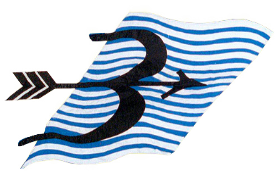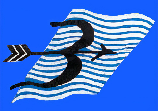The Bowater company began in an unspectacular, indeed slightly disreputable, fashion.
In 1881 William Vansittart Bowater (1838-1907) was dismissed by a Manchester papermaker who had tired of his hard-drinking and bad temper. Bowater moved to London and set up in business as agent, selling the produce of paper mills to printers.
What transformed this modest family company into a global manufacturing corporation was the arrival on the board of the founder’s grandson, Eric Vansittart Bowater (1894-1962). Eric Bowater sought to move from agent to manufacturer, and in 1926 opened his own mill at Northfleet on the Thames, well-placed for the import of Scandinavian or Canadian woodpulp.
Within four years, Bowaters had opened another mill at Ellesmere Port, a joint venture with Lords Rothermere and Beaverbrook who wanted newsprint for their Manchester works which printed northern editions of the Daily Mail and Daily Express. Like Northfleet, the Mersey Mill had excellent access for ships via the Manchester Ship Canal. However, Eric Bowaters’s major coup was the acquisition in 1936 of an interest in the mills at Kemsley and Sittingbourne in Kent owned by Edward Lloyd Ltd. These large mills provided much of the newsprint for the London daily and weekly papers and had their own facilities for importing pulp at Ridham Dock.
The consortium of newspaper proprietors who owned these mills was impressed with Eric Bowater’s abilities and decided that he should run the mills, which he did under the title Bowater Lloyd Pulp and Paper Mills Ltd. In little more than a decade, Eric Bowater had built up a business which controlled 60% of the UK’s newsprint.
Bowaters became owners of deep-sea ships almost incidentally to other acquisitions. Eric Bowater was convinced that his company needed to control the source of its raw materials, being suspicious of his wood pulp suppliers in Scandinavia. In the 1930s he began discussion with the Government of Newfoundland about building his own pulp mill amidst abundant sources of timber at Gander. However, during negotiations Bowater was offered an existing Newfoundland mill, the Corner Brook operation of the International Power and Paper Co. of Newfoundland Ltd.
The mill had been built in 1922 but had yet to make a profit, and Bowater realised he could secure his raw material supplies much more economically and quickly by buying the Corner Brook operation than by building his own mill: 7,000 square miles of virgin forest came with the mill.
In May 1938 Corner Brook passed to Bowater’s Newfoundland Pulp and Paper Mills Ltd., and with it came two ocean-going steamers, the Humber Arm and Corner Brook. These had been built by Armstrong, Whitworth and Co. Ltd. in 1928, and their original owners, the Newfoundland Power and Paper Utilities Corporation Ltd., becoming in 1928 the International Power and Paper Co. of Newfoundland Ltd. These ships were managed by Furness Withy and ran between the mill, east coast ports in the United States and the UK, they unloaded at Northfleet on the Thames.
In July 1940, Humber Arm was crossing the Atlantic with a cargo which included pulp for Ellesmere Port, plus newsprint and steel when torpedoed by the infamous U99. Fortunately, being in convoy probably saved her crew and passengers who were all rescued. The loss of Humber Arm, and the threat of a shortage of ships as the British Government hastened to control shipping capacity for its war effort, persuaded Bowaters to obtain more ships to maintain supplies to its mills.
Ships were in desperately short supply in 1940, and it proved impossible to buy anything British owned. However, a motley fleet was somehow assembled, including two US-built steamers bought from China, one former Elder Dempster steamer acquired from Argentina, and two from a Canadian owner that, by their dimensions, were lakers.
Only one of these acquisitions was to survive the war, and Bowaters did not even take delivery of the Betty, which had loaded a cargo of rice in Saigon for Liverpool, only to be torpedoed off Tory Island within a day of her destination.
The ageing ex-Elder Dempster steamer which had been renamed Kitty’s Brook was torpedoed in May 1942 and Waterton in November of that year, both in Canadian waters whilst on voyages to or from the USA. Livingston, Waterton’s sister laker/canaller, succumbed in the same waters during September 1944 in what was a late attack by the not-quite defeated U-boat arm. Only the pioneering Corner Brook and the US-built North Brook survived to the end of the conflict, after which the latter returned to Shanghai register. Corner Brook soldiered on alone, the sole vessel of Bowater’s Newfoundland Pulp and Paper Mills Ltd., until scrapped at Hamburg in 1954.
To complete the story of this very mixed fleet, we also need to mention the steamer R.J. Cullen, bought in 1940 by the Atlantic Transportation Co. Ltd. and managed by the International Power and Paper Co. of Newfoundland Ltd. She had an origin equally as exotic as the Bowaters’ distress purchases, having been completed in Japan in 1919 for the United States Shipping Board. Her fate was to be just as dismal as the Bowaters’ ships, however, as in January 1942 she was wrecked on the island of Barra in the Outer Hebrides whilst on ballast passage from Liverpool to Sydney, Nova Scotia.
Following the scrapping of Corner Brook in 1954, Bowaters were without deep-sea vessels for just seven months. The high cost of chartering during the Korean War gave Sir Eric Bowater an excuse to buy ships, but a clue to his real motive was a remark of a successor that ‘every great man wishes to own a newspaper or own ships. Having made his decision, Bowater consulted widely.
In anticipation of the scrapping of Corner Brook, two ships had been ordered from Dennys of Dumbarton. A detailed analysis of Bowater Paper Corporation’s use of sea transport concluded that it needed to ship over one million tons of raw material each year, serving its mills in Scandinavia, Canada and one which was soon to open at Calhoun in Tennessee. It was calculated that this required not merely two ships, but a total of three medium size and five smaller ships (six smaller ships were eventually built). It was also decided that a subsidiary should be set up to own this fleet.
In January 1955 the Bowater Steamship Co. Ltd. was formed in London with one million pounds of capital subscribed by the Bowater Paper Corporation, the rest of the four million needed being borrowed. The first two ships were actually ordered by, and launched for, Bowater’s Newfoundland Pulp and Paper Mills Ltd., Corner Brook, Newfoundland but were transferred to the new London based company before delivery.
Bowaters did not want to do its own management, and left this to Furness, Withy who had managed the Corner Brook and Humber Arm. This arrangement lasted until 1960 when Cayzer, Irvine and Co. Ltd. - later the British and Commonwealth Shipping Co. Ltd. - were appointed managers.
On 21st February 1955 the turbine-driven Margaret Bowater was delivered. She and her sister, Sarah Bowater, were designed primarily as newsprint carriers, for use on the Atlantic coast of North America from Corner Brook down to the Gulf of Mexico and across the Atlantic to the United Kingdom. As anyone who has seen newsprint being handled will appreciate, a roll is large and heavy, but also very vulnerable to damage. Crews were told that a one inch tear in a roll could make a mile of paper unusable. To avoid damage pillars were eliminated from the holds of Margaret Bowater and her sisters, and where possible other obstructions avoided. Sparring in the holds was covered with rubber to help protect the paper rolls. In winter the ships had to steam through ice which could be eighteen inches thick for about twenty miles on a voyage to Corner Brook, and so they were ice strengthened and had well-rounded forefoots. Margaret Bowater had accommodation for six or eight guests, and Sarah Bowater also had an owner’s suite. Sir Eric had a reputation for lavish entertaining, and the accommodation was designed with this in mind. On one occasion he used one of the ships, probably the Sarah Bowater, for a private cruise in the Caribbean.
The choice of the Denny yard to build the first of Bowater’s newsprint carriers is interesting, as in 1952 the Dumbarton builders had completed what was described as the first ship designed entirely for carrying newsprint. This was the Markland of the Vinland Shipping Co. Ltd., a company owned ultimately by the Mersey Paper Co. Ltd. of Liverpool, Halifax.
The 1954 review of Bowaters’ sea transport needs envisaged five smaller ships, suitable for the pulp trade from Scandinavia to the UK, although they would also be able to serve the Newfoundland and Tennessee mills. They were to be capable of carrying baled pulp or newsprint. To aid manoeuvrability in restricted waters, the new ships were fitted with Pleuger Activ rudders, and Elizabeth Bowater was to be the first British ship to be built with this equipment. On the rudder blade was a pear-shaped housing incorporating a 150 hp electric motor which drove a small propeller. The operation of this gave enough steering torque even when the vessel had very little way on.
The pioneer, Elizabeth Bowater, came from Caledon’s yard at Dundee, but Denny’s could take the credit for most of the design work, including lines, machinery arrangements and general arrangement. Dennys actually built two of the six ships which were eventually completed to this design, three coming from Caledon (who prepared the steelwork plans) and one from Cammell Laird who were allowed to draw up piping and other fitting plans. Such co-operation between yards ostensibly in competition seems to have been not uncommon, but building of just six ships in three yards over three and a half years suggests that little importance was placed on the savings achievable with series construction. However, Dennys did build all but one of the Sulzer engines, the exception coming from Werkspoor in Amsterdam. All were six-cylinder, single-acting, two-stroke engines giving a modest 12 knots.
On the delivery of the last of the small pulpwood carriers, Nina Bowater, in 1961 the Bowater Steamship fleet reached its all-time peak of twelve ships, including three survivors of the Mersey Paper fleet. However, it was then downhill all the way.
The first two of the big newsprint carriers were sold after just 13 years’ service. Turbine-driven general cargo ships became unpopular as oil prices increased, and this pair only managed a pathetic 15 to 16 years’ total service before being broken up in Taiwan, although Nicolas Bowater was to do slightly better.
By 1973 inroads had also been made into the motor ships, with the Werkspoor-engined Alice Bowater managing only ten years in the fleet. The last ship to remain with Bowaters was also the last built, Nina Bowater, sold in 1977. However, the motor ships have survived much better than the turbine ships, and two survived into the 21st century.
Several had interesting later careers. Elizabeth Bowater became a drill ship, which contributed to her outliving all her sisters, although much of her later years were spent laid up. Alice Bowater was bought for use as a cadet training ship by the Maritime College of Quebec, and as Quebec made at least one return visit to the Mersey. Perhaps the best known survivor was the former Phyllis Bowater, which spent 18-years under the Turkish flag as Naz-K, and completed a total of 40 years’ service.
In seeking reasons for Bowaters to run down their fleet one can cite the increasing costs of operating under the British flag and the attraction of being able to charter in ships as needed, making savings by employing ships at prevailing market rates.
When the Bowater Steamship Co. Ltd. fleet was being planned, too many cargoes were chasing too few ships, a situation which has not often prevailed since. However, Bowater’s fortunes have also declined, especially since the death of Eric Bowater in 1962. His organisation’s rapid growth was funded (as was his fleet) by heavy borrowing, and a world over-capacity for newsprint meant the debt-laden Corporation had to shed many of its assets to make ends meet.
With their mills in Kent and Cheshire sold, Bowaters are no longer the force they once were in paper, and their remaining UK operations are limited to tissue production (Bowater Scott), packaging, and an interest in building materials.
The North American operation is much more vibrant, however, and Bowaters are the major producer of newsprint in the US, with mills in Tennessee, South Carolina, Maine and Nova Scotia.
Bowater’s shipping operations – which ended over 30 years ago - should be remembered as a bold and perhaps somewhat flamboyant venture of an entrepreneur who was never afraid to take risks.






















































